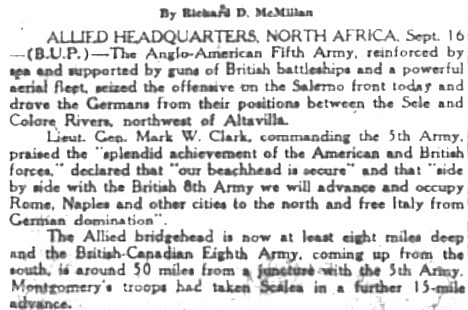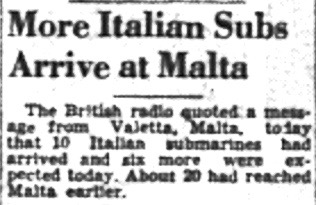Action is Hot in Italy; My Own Search is Cold
To capture Rome, the Allies first had to go through Hell for months
Allied forces landed in Sicily in July, 1943 and invaded Italy two months later, beginning with Operation Baytown on September 3.
Involved in Baytown, some Canadians in Combined Ops manned a flotilla of landing crafts for 30+ days, transporting troops and materiel of war from Messina, Sicily to Reggio di Calabria, Italy (the toe of the boot).
Future landings of troops (UK, US, Canadian, etc.) took place at Salerno, Naples, Anzio, Taranto and other sites. They were fiercely opposed by Axis armies, well-prepared and very determined in cold, hard defensive positions. Rome was not captured until one or two days before D-Day Normandy in June, 1944.
My research deals with trying to find related information about a particular trip by a Canadian Landing Craft, Mechanised (LCM) across the Strait of Messina. On board was a reporter of The Montreal Star.
When? I'm not sure.
Who was the reporter? I'm not sure. Maybe it was Sholto Watt. I know he was in the neighbourhood (Sicily, Malta, Italy).
Did Mr. Watt mention names of officers or sailors manning that particular LCM? I hope so. My father may have been on board.
So far I have found little information about Canadians in Combined Ops but I know I'm getting close if Sholto Watt is my guy. Articles he wrote show up in my next two posts and he touches on details re Sicily and Malta. Italy could be next! : )
Until then I will continue to share material from The Montreal Star that provides some flavour and context and education concerning the work being done by Allied forces in The Med, knowing Canadians played an important role.
Monty was leading UK troops and Gen. M. Clark was leading US troops:
More about General Mark Clark can be found here.
I have heard of "barrage balloons" in various books and memoirs but not "balloon barrage crews." Until now...
Though the Dieppe Raid took place one year earlier (August19, 1942), occasional pieces of news about its repercussions or brave participants appear:
The rocket gun aka "bazooka" makes an appearance and an impact:
Editorial cartoons appear daily in The Montreal Star. Adolf Hitler remains a popular target:
The Russians are coming!
Cartoons (ads) re Victory Bonds, War Savings Stamps are everywhere,
as regular as Editorial cartoons
Because my main interest is Canadians in Combined Ops and their significant war efforts re transporting or ferrying men and materiel of war, it seems only natural to plug another team of players also working non-stop to keep men and war supplies on the go:
As the story continues we see how transport systems, including landing crafts, is linked to communication systems. "No small roles" comes to mind:
"Keep well supplied!"
Salerno is a significant port in Italy, south of Naples. Action was hot there!
Most of The Star's photos do not travel well in modern times, but surely there is an archive somewhere... in Montreal? (it's on my to-do list!)
What do Casablanca and Quebec have in common?
Casablanca and Quebec were sites for two very
significant meetings between Allied leaders
Note the last paragraph above. Who was that correspondent?
The correspondent was Michael Chinigo:
More can be found about M. Chinigo by subscribing to a monetized site re The New York Times. Below is offered at no cost:
ROME, Oct. 11 (AP)—Michael Chinigo, 66 years old, a longtime foreign correspondent, for the now‐defunct International News Service and United States newspapers, died today from a bullet wound in the head suffered two months ago. The police said then that the wound had been self‐inflicted.
An Albanian‐born United States citizen, Mr. Chinigo served during World War II as a correspondent for I. N. S., which was later merged with United Press to form United Press International. He covered United States Army landings in Sicily and Anzio and the last few months of the war in Italy.
He was awarded the Silver Star for bravery during the Sicilian invasion.
Mr. Chinigo, who had attended Yale and the University of Rome, remained in Italy for I.N.S. after the war and later worked for several United States newspapers.
- The New York Times, October 12, 1974
And now, some final clips from The Montreal Star:
What once went east now goes west! Hitler's retreat on old No. 13
This final news clipping reveals how some events during the war were very close run affairs, and things could have turned out quite differently if...
The story of Malta also contains elements
of being on the very brink!
More stories to follow.of being on the very brink!
Please link to Editor's Research: Invasion of Italy (11) - Montreal Star (Sept. 14-15, '43)
Unattributed Photos GH




































No comments:
Post a Comment